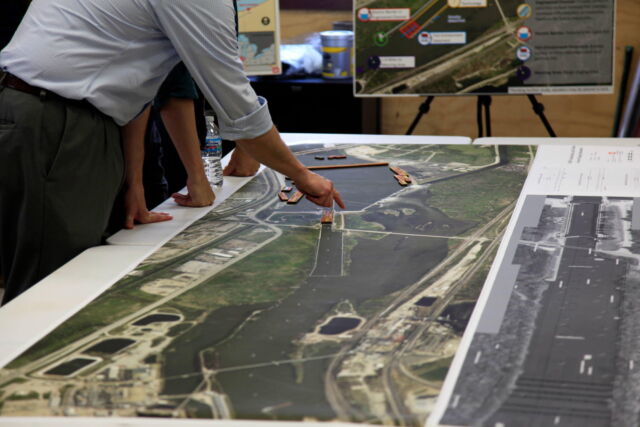
Over the past 50-some years, invasive carp, a stunningly destructive invasive species, have infested almost every waterway in the Midwest, from South Dakota to beyond the Mississippi Delta, and have even reached West Virginia. In some waters, it has been reported that around 90 percent of the fish are invasive carp; in one section of the Illinois River, a Mississippi tributary, they make up more than 75 percent of the total biomass in the water. They are obnoxious invaders, overwhelming other fish species, muddying clear waters, and—in some cases—jumping out of the water when startled. A passing boat can throw hundreds of fish into a frenzy, creating an airborne blizzard of 25-pound lunkers that have broken the arms and jaws of recreational boaters.
So far, however, the prolific fish have mostly stopped short of the Great Lakes, blocked by the subtle ridge of a continental divide that circles the lakes’ southern and western shores. Water to the west and south of the ridge flows to the Mississippi River and the Gulf of Mexico. Water to the east and north flows to the Great Lakes, which contain about 20 percent of the world’s surface fresh water and attract boating, fishing, and other recreation, which all together have been estimated to generate between $14 billion and $42 billion a year.
But the fish, formerly called Asian carp, could still find a way in. There is a single year-round connection between those two main watersheds of eastern North America: the Chicago Sanitary and Ship Canal.
The canal opened to commercial shipping in 1900, and an extension was built seven years later; among the unintended consequences was the creation of a route for invasive species like the carp to move into vast new territories. It connects Lake Michigan and the Chicago River to the Des Plaines River, which pours into the Illinois River, which is lousy with invasive carp.
At the Brandon Road Lock and Dam, south of Joliet, Illinois, below where the canal and Des Plaines River meet, there is a choke point, a 110-foot wide channel and lock through which the carp must pass to get to the Great Lakes. There, the Army Corps of Engineers is mustering about $1.2 billion taxpayer dollars to build a barrier that will, hypothetically, stop the carp from getting to the lakes.

Experts say that keeping the fish out is worth the price. “It would be a cataclysmic event,” said Greg McClinchey, legislative affairs and policy director of the Great Lakes Fishery Commission, contemplating the arrival of invasive carp in the lakes. “As expensive as any project might be, the cost of failure is much higher.” (The commission is also working with partners in Ohio to control invasive grass carp that have established a small breeding population in the Lake Erie watershed, but these fish are not as big of a threat as other invasive carp species.)
What is officially called the Brandon Road Interbasin Project is, in effect, the Great Lakes’ last line of defense. It will be a gauntlet of barriers that will take years to install and use a variety of technologies, from electric shocks to curtains of bubbles, to inflict sufficient discomfort on the advancing carp that they may turn around and leave the Great Lakes alone.
“I have great hope that the technologies will work,” said Molly Flanagan, chief operating officer of the nonprofit Alliance for the Great Lakes. “One open question is whether we can build them fast enough.”
There are four types of invasive carp: bighead, silver, grass, and black. Although the exact date of the invasive carp’s introduction is unclear, the fish were deliberately introduced into the United States, possibly in the early 1960s, first as a sport fish and then, improbably, as the solution to an environmental problem: the heavy use of herbicides to clear weeds from catfish farms in the Mississippi Delta. The bottom feeding carp would root up weeds and consume floating algae.
“The understanding was that there was no way these fish could reproduce in this environment,” said Brian Schoenung, the aquatic nuisance species program manager for the Illinois Department of Natural Resources. “It was a great way to cut back the chemicals.”
In the early 1970s, flooding liberated thousands of the imported carp from the catfish ponds, washing them into tributaries of the Mississippi. It turns out that they reproduced in American waters just fine, and they soon wreaked havoc on the waterways and native species. “It is the pig of the fish world,” wrote outdoor writer Mark C. Dilts of the carp, “rooting around in a weed bed, which it will eventually destroy as habitat for other fish. Its plowing around on bottom muddies the water so sunlight cannot penetrate to stimulate future plant growth.”
"fish" - Google News
June 15, 2023 at 08:40PM
https://ift.tt/mXupaC1
Inside the battle to build a $1.2 billion fish barricade - Ars Technica
"fish" - Google News
https://ift.tt/4vftOqC
https://ift.tt/gaT3BzS
Bagikan Berita Ini















0 Response to "Inside the battle to build a $1.2 billion fish barricade - Ars Technica"
Post a Comment